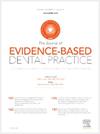亲水与疏水沟沟密封剂的固位与防龋效果比较:系统回顾与meta分析
IF 4
4区 医学
Q1 DENTISTRY, ORAL SURGERY & MEDICINE
引用次数: 0
摘要
牙科密封剂通过保护牙槽和牙缝免受食物和微生物积聚的影响,对预防龋齿至关重要。密封剂分为疏水性和亲水性。疏水密封胶在潮湿环境中表现出较高的保持性,但效果较差,亲水密封胶在这种条件下表现更好。评估这些密封剂的固位和预防龋齿的功效是优化牙科保健实践的必要条件。这篇综述评价了两种密封剂的固位和龋齿预防效果。材料与方法提取研究设计、样本量、密封剂类型、随访时间、保留率、继发龋发病率等数据。采用RevMan 5.4评估偏倚风险,并根据纳入研究的异质性和性质,采用随机效应模型和固定效应模型进行meta分析。结果15项随机对照试验(rct)和3项非随机对照试验(NRCTs)符合PRISMA指南的纳入标准。亲水性密封剂在3个月(OR: 3.00, 95 % CI: 1.46-6.16)和12个月(OR: 2.00, 95 % CI: 1.35-2.96)时的保留率显著较高。然而,在6、9和18个月时没有观察到显著差异。在所有随访期间,两种类型的密封剂预防龋齿的效果相似,异质性低,表明结果一致。亲水密封胶最初提供更好的保持性,由于防潮性能,但不能长期保持这种优势。两种类型的密封剂在预防龋齿方面同样有效。这些发现与先前的研究一致,强调了密封胶应用中湿度控制的重要性。结论与疏水密封剂相比,亲水密封剂具有较好的短期固位性和相似的防龋效果。本文章由计算机程序翻译,如有差异,请以英文原文为准。
COMPARATIVE EVALUATION OF RETENTION AND CARIES PREVENTIVE EFFECT OF HYDROPHILIC AND HYDROPHOBIC PIT AND FISSURE SEALANTS: A SYSTEMATIC REVIEW AND META ANALYSIS
Background
Dental sealants are critical in preventing caries by protecting pits and fissures from food and microorganism accumulation. Sealants are categorized as hydrophobic and hydrophilic. Hydrophobic sealants exhibit higher retention but less effective in moist environments, hydrophilic sealants perform better under such conditions. Evaluating retention and caries prevention efficacy of these sealants is essential for optimizing dental care practices. This review evaluates retention and caries preventive efficacy of both sealants.
Materials and Methods
Data on study design, sample size, sealant type, follow-up duration, retention rates, and secondary caries incidence were extracted. The risk of bias assessed using RevMan 5.4, and meta-analyses were conducted with both random-effects model and fixed-effects model based on heterogeneity and nature of included studies.
Results
Adhering to PRISMA guidelines, 15 Randomized Controlled Trials (RCTs) and 3 Non-Randomized Controlled Trials (NRCTs) met with inclusion criteria. Hydrophilic sealants showed significantly higher retention rates at 3 months (OR: 3.00, 95 % CI: 1.46-6.16) and 12 months (OR: 2.00, 95 % CI: 1.35-2.96). However, no significant differences observed at 6, 9, and 18 months. Caries prevention efficacy was similar for both sealant types across all follow-up periods, with low heterogeneity indicating consistent results.
Discussion
Hydrophilic sealants initially provide better retention due to moisture-resistant properties but do not sustain this advantage in long run. Both sealant types are equally effective in preventing caries. These findings align with prior studies, emphasizing importance of moisture control in sealant application.
Conclusion
Hydrophilic sealants exhibit superior short-term retention and similar caries prevention efficacy compared to hydrophobic sealants.
求助全文
通过发布文献求助,成功后即可免费获取论文全文。
去求助
来源期刊

Journal of Evidence-Based Dental Practice
DENTISTRY, ORAL SURGERY & MEDICINE-
CiteScore
6.00
自引率
16.70%
发文量
105
审稿时长
28 days
期刊介绍:
The Journal of Evidence-Based Dental Practice presents timely original articles, as well as reviews of articles on the results and outcomes of clinical procedures and treatment. The Journal advocates the use or rejection of a procedure based on solid, clinical evidence found in literature. The Journal''s dynamic operating principles are explicitness in process and objectives, publication of the highest-quality reviews and original articles, and an emphasis on objectivity.
 求助内容:
求助内容: 应助结果提醒方式:
应助结果提醒方式:


